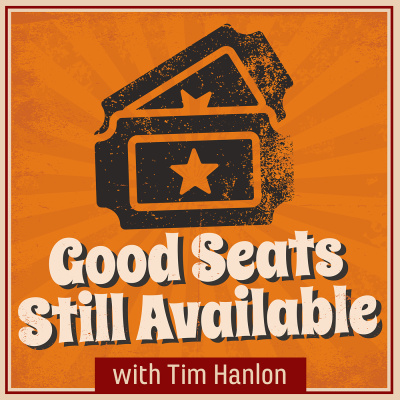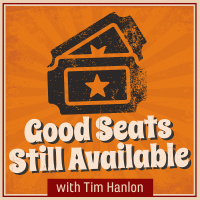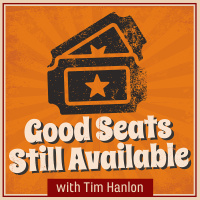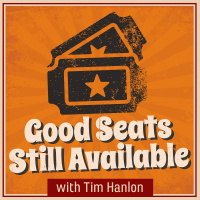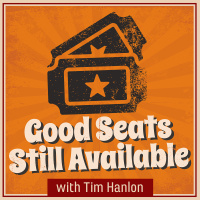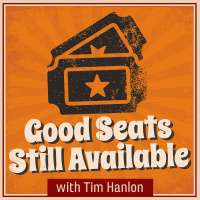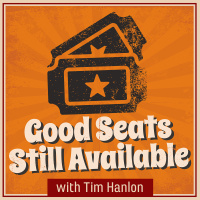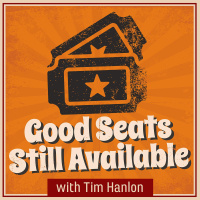Synopsis
Good Seats Still Available is a curious little podcast devoted to the exploration of what used-to-be in professional sports. Each week, host Tim Hanlon interviews former players, owners, broadcasters, beat reporters, and surprisingly famous "super fans" of teams and leagues that have come and gone - in an attempt tounearth some of the most wild and woolly moments in (often forgotten) sports history.
Episodes
-
051: The Wild & Wacky World Football League with Author Mark Speck
05/03/2018 Duration: 01h31minPerhaps no defunct league in modern-day professional sports history endured a more ignominious storyline and spectacular demise than that of the World Football League – a uniquely disastrous attempt to establish a summer-into-autumn rival to the National Football League during the mid-1970’s. Brimming with confidence from his co-founding exploits with two previous (and at the time, still very-much-alive) challenger pro circuits – the American Basketball Association in 1967, and the World Hockey Association in 1971 – WFL founder/commissioner Gary Davidson saw the 1974-era National Football League as the next logical target for his quintessentially anti-establishment sports management ambitions. While the ABA and WHA both eventually yielded successful mergers of their most viable franchises into their established rivals, the World Football League quickly proved to be quite different – and, ultimately, Davidson’s professional and personal Waterloo. The WFL initially succeeded in persuading dozens of NFL stars t
-
050: National League Baseball’s Detroit Wolverines with Author Brian “Chip” Martin
26/02/2018 Duration: 01h16minWhile the Detroit Tigers hold the record as the oldest continuous one-name, one-city franchise in the American League (debuting as one of the league’s “Classic Eight” charter clubs in 1901), they were not the first team to play major league baseball in the Motor City. That distinction actually goes to the Detroit Wolverines of the late 19th-century National League, which took to the field for the first time against the visiting Buffalo Bisons on May 2, 1881 in front of a curious crowd of 1,286 at Recreation Park – land now occupied by today’s Detroit Medical Center in the city’s Midtown. Playing in what was then one of the best professional ballparks in America – and during a pre-automotive era when Detroit was known more sumptuously as the "Paris of the West" – the Wolverines traipsed through eight seasons of big league ball, including its final three under the brash and ambitious ownership of pharmaceutical baron Frederick Stearns that produced 1887 National League and “World Championship” titles, boasted
-
049: “Rock & Roll” NASL Soccer with Author Ian Plenderleith
19/02/2018 Duration: 01h23minBy many accounts, the North American Soccer League was a one-of-a-kind phenomenon in the history of the world game – and, during its 1970s heyday (although it began shakily in 1968 and ended in shambles after the 1984 season) – a league years ahead of its time. More than just Pelé and the star-studded, bigger-than-life New York Cosmos, the NASL lured international soccer’s biggest names like Johan Cruyff, Eusebio, George Best, and Franz Beckenbauer to play the “beautiful game” the way it was meant to be played—uninhibited, and with fan-pleasing innovations like sudden-death overtime, a 35-yard-line offsides demarcation, tie-breaking shootouts, and a points system that incentivized scoring regardless of result. For international players, the NASL provided a bright and shiny alternative (or at least, summertime off-season respite) to the drearily conservative and cynically defensive state of the European game of the day. Plush modern stadiums, professional cheerleaders, pre-game tailgating, clever promotional
-
048: How the ABA’s Indiana Pacers Helped “Change the Game” – with Bob Netolicky & Robin Miller
12/02/2018 Duration: 01h25minFour-time American Basketball Association All-Star Bob Netolicky and former Indianapolis Star sportswriter Robin Miller join host Tim Hanlon to share some of their most memorable (and heretofore untold) first-person accounts of playing and traveling with the thrice-ABA-champion Indiana Pacers – and promote their upcoming book We Changed the Game, penned in partnership with original team co-founder/owner Dick Tinkham. Despite three championships, five finals appearances and the strongest fan base in the league, the Pacers – and by extension, the ABA itself – barely survived a number of remarkably close calls and dire financial situations during their collective nine-year pre-NBA-merger existence that nearly sank both the franchise and the league more than once. Yet, in the end, the team and the city improbably (and inspirationally) rallied together to keep the team (and the league) afloat – to ultimately become one of the four surviving franchises in the landmark merger with the National Basketball Associatio
-
047: US Pro Soccer’s 1960s-Era Rebirth with Author Dennis Seese
05/02/2018 Duration: 02h01minThe history of professional soccer in the United States is richer and far more complex than today’s generation of Major League Soccer fans might realize. Multiple ethnically-infused pro leagues existed as far back as the early 1900s – but when the American Soccer Association collapsed in Depression-Era 1933, it wasn’t until the mid-1960s when the next serious attempt to bring full-fledged, top-flight Division One professional soccer to US shores was pursued in earnest. In 1966, suddenly and incredibly, no fewer than three separate groups of well-heeled American sports businessmen coalesced around the same idea, each attempting to draft off of attention-generating events like entrepreneur Bill Cox’s International Soccer League tournaments and NBC’s surprisingly high-rated, near-live national TV broadcast of the World Cup Final from England. According to research librarian (and unwitting soccer historian) Dennis Seese (The Rebirth of Professional Soccer in America: The Strange Days of the United Soccer Assoc
-
046: The United States Football League with Author Paul Reeths
29/01/2018 Duration: 02h13minFor the first time since Episode #11, we return to the brief, but unforgettable streak of pro football lightning known as the United States Football League, with the author of its definitive history, Paul Reeths (The United States Football League, 1982-1986). The brainchild of New Orleans plywood manufacturer/car dealer/World Championship Tennis co-founder/Superdome director/art-and-antiques dealer David Dixon, the USFL splashily announced its intention to bring big-league, springtime professional football to 12 major markets, at New York’s famed “21” Club on May 11, 1982. In short order, the league added its first commissioner (sports cable TV executive Chet Simmons), a landmark marquee player signing (Heisman Trophy winner Herschel Walker), and, most valuably, national television contracts with broadcaster ABC Sports and upstart cable network ESPN. In this illuminating episode, Reeths recounts some of the most memorable (and unbelievable) events from the USFL’s subsequent three-season run – and ultimatel
-
045: The ABA’s Indiana Pacers with Sportswriter Mark Montieth – Part Two
22/01/2018 Duration: 01h35minVeteran sportswriter Mark Montieth (Reborn: The Pacers and the Return of Pro Basketball to Indianapolis) returns to the podcast (Episode #41) to help complete the story of the Indiana Pacers’ nine-year sojourn through the American Basketball Association – including its shaky transition into a merger-expanded NBA in 1976. Arguably the most stable and successful franchise in the ABA’s short but colorful history, the franchise nearly collapsed under its own weight after its inaugural National Basketball Association campaign – if not for a hastily arranged 1977 Independence Day weekend telethon fundraiser devised by head coach Bobby “Slick” Leonard and his wife Nancy, that miraculously saved the team and cemented its place in the Indianapolis cultural landscape. Along the way, however, the ABA Pacers made indelible marks on both the city and the basketball establishment, including: barn-burning rivalries (especially with the Kentucky Colonels and Utah Stars); stellar local collegiate talent signings (includ
-
044: Arena Football League Founder Jim Foster - Part Two
15/01/2018 Duration: 01h47minWe conclude our two-part journey into the early history of the Arena Football League with founder and inventor Jim Foster, who recounts some of the most notable events of the league’s formative years – including a memorable 1987 “demonstration season” featuring: The February debut “Showcase Game” in suburban Chicago’s Rosemont Horizon between the hometown Bruisers and the Miami Vise – highlights of which later dominated ESPN’s SportsCenter; A return to the Horizon for the first-ever nationally televised league match four months later (after a non-televised inaugural game the night before in Pittsburgh) – an overtime thriller that left fans, ESPN broadcasters, and league officials scrambling for the newly-written rule book; The league’s first “Arena Bowl” championship game (won by the visiting Denver Dynamite) in front of a sold-out Pittsburgh Civic Center and a live national TV audience; AND US patent filings (officially granted in the spring of 1990) protecting the original rules, play and configuration of
-
043: Arena Football League Founder Jim Foster
08/01/2018 Duration: 02h18minAs the new year beckons, the fate of the Arena Football League – one of America’s most innovative modern-day professional sports concepts – hangs in the balance. With only four teams (the mutually-owned Washington Valor and Baltimore Brigade, defending champion Philadelphia Soul, and a still-unnamed Albany, NY squad) confirmed for the upcoming 2018 season, the AFL will play with exactly the same number of franchises that comprised its inaugural “demonstration” season back in 1987 – and a mere fraction of the 19 clubs that competed during its heyday in the early-to-mid 2000s. Much has happened to the league and the sport during those 30+ years, of course – and few doubt that the unique (and once-patented) excitement of arena football won’t eventually find a sustainable business model and a return to long-term stability. In the interim, however, we delve into how it all began, with the first of our two-part interview with Iowa native Jim Foster – the inventor of arena football and the founder of the original
-
042: Entertainer Pat Boone and the ABA’s Oakland Oaks
01/01/2018 Duration: 01h21minWe usher in the holidays and round out our debut season with the inimitable Pat Boone – an American entertainment legend and inveterate business entrepreneur, with a life-long passion for the sport of basketball. In a career spanning over six decades (and counting!), the incomparable Boone has just about done it all in the fields of music, film, television, and stage, as well as the pursuit of a wide variety of business interests – including being the majority owner of the American Basketball Association’s charter Bay Area franchise, the Oakland Oaks. Denied the ability to play its NBA All-Star marquee signing (and cross-town San Francisco Warriors star) Rick Barry for the inaugural 1967-68 ABA season, Boone’s Oaks endured a league-worst 22-56 record, amid dismally low crowds at the brand-new Oakland-Alameda County Coliseum Arena. Barry’s official arrival the next season (despite a knee injury that curtailed his play after only 35 games), paired with the hiring of two-time NBA champion head coach Alex Hannu
-
042: Entertainer Pat Boone and the ABA’s Oakland Oaks
25/12/2017 Duration: 01h21minWe usher in the holidays and round out our debut season with the inimitable Pat Boone – an American entertainment legend and inveterate business entrepreneur, with a life-long passion for the sport of basketball. In a career spanning over six decades (and counting!), the incomparable Boone has just about done it all in the fields of music, film, television, and stage, as well as the pursuit of a wide variety of business interests – including being the majority owner of the American Basketball Association’s charter Bay Area franchise, the Oakland Oaks. Denied the ability to play its NBA All-Star marquee signing (and cross-town San Francisco Warriors star) Rick Barry for the inaugural 1967-68 ABA season, Boone’s Oaks endured a league-worst 22-56 record, amid dismally low crowds at the brand-new Oakland-Alameda County Coliseum Arena. Barry’s official arrival the next season (despite a knee injury that curtailed his play after only 35 games), paired with the hiring of two-time NBA champion head coach Alex Hannu
-
041: ABA Basketball’s Indiana Pacers with Sportswriter Mark Montieth
18/12/2017 Duration: 01h25minLong-time Indianapolis pro hoops beat reporter Mark Montieth (Reborn: The Pacers and the Return of Pro Basketball to Indianapolis) joins host Tim Hanlon to delve into the intriguing story behind the efforts of late-1960s civic leaders to re-establish a top-tier professional franchise in the capital city of basketball-mad Indiana after a curious 14-year absence. One of eleven charter franchises in 1967’s upstart American Basketball Association, the Indiana Pacers literally and figuratively “set the pace” early and often during the league’s nine-year existence – amassing three ABA championships, five finals appearances, and a dazzling array of All-Star talent including the likes of Freddie Lewis, Bob Netolicky, Billy Knight, and future Naismith Memorial Basketball Hall of Fame inductees Roger Brown, Mel Daniels, George McGinnis, and head coach Bob “Slick” Leonard. In a league synonymous with wild games, outsized personalities and vagabond franchises, the Pacers were a uniquely steady constant on the court, i
-
040: The Three Acts of Pro Soccer’s San Jose Earthquakes with Columnist Gary Singh
11/12/2017 Duration: 01h33minLong-time Metro Silicon Valley columnist and San Jose, California native Gary Singh (The San Jose Earthquakes: A Seismic Soccer Legacy) joins host Tim Hanlon to discuss the confusing journey and three distinct incarnations of one of American soccer’s most colorful and persistent professional franchises. As one of four West Coast expansion teams (along with the Los Angeles Aztecs, Seattle Sounders and Vancouver Whitecaps) added for the North American Soccer League’s breakthrough 1974 season, the original San Jose Earthquakes were an immediate hit both on the field (finishing second in the all-new Western Division, and led by the league’s leading scorer Paul Child) and in the stands, where they drew in excess of 15,000 fans a game to a less-than-modern Spartan Stadium – more than double the league average. Though never regular championship contenders, the ‘Quakes cultivated a rabidly loyal fan base that became the envy of clubs across the league – until the NASL’s ultimate demise ten years later. Elements o
-
039: The Continental Indoor Soccer League’s Indianapolis Twisters with Broadcaster Kenn Tomasch
04/12/2017 Duration: 01h40minFormer sportscaster and fellow defunct pro sports enthusiast Kenn Tomasch joins host Tim Hanlon to dig deep into the two-season saga of the Indiana (née Indianapolis) Twisters of the Continental Indoor Soccer League – the mid-90s summertime indoor soccer circuit hatched by a collective of team and arena owners from the NBA and NHL to keep their facilities humming during their respective “off”-seasons. CISL franchises controlled by entities outside the big-league fraternity were also part of the mix (accounting for half of the eventual 18 teams during the league’s five-year run from 1993-97) – including the tumultuously tenuous Twisters, who cycled through two separate ownership groups as well as a temporary spell of league receivership during its brief 21-month existence. As the radio “Voice of the Twisters,” Tomasch was there for all of it, including: A rousing home debut on June 21, 1996 at Indianapolis’ Market Square Arena that saw the club drop an entertaining 7-6 overtime decision to the Washington War
-
038: Women’s Professional Baseball with Film Producer/Director Jon Leonoudakis
27/11/2017 Duration: 01h10minDocumentary film producer/director Jon Leonoudakis (The Wrecking Crew!) joins Tim Hanlon to discuss Season Three of his digital video series The Sweet Spot: A Treasury of Baseball Stories – devoted to the plight of women in the pursuit of playing America’s pastime. Over this season’s nine episodes, Shutout! The Battle American Women Wage to Play Baseball tackles the tortuous journey of women in baseball from multiple angles – including notable attempts at professional play over the last century, such as: The All-American Girls Professional Baseball League – launched in wartime 1943 to keep interest in the sport alive while enlisted male players served overseas, the AAGPBL continued well into the early 1950s with a spirited blend of competitive moxie and girl-next-door femininity that delighted hundreds of thousands of fans across the Midwest and inspired a landmark 1992 film (A League of Their Own) that cemented its legacy generations later; The Colorado Silver Bullets – formed in 1994 in the wake of the su
-
037: The NHL’s California Golden Seals with Author Steve Currier
20/11/2017 Duration: 01h35minIce hockey makes its long-awaited return to the podcast, as host Tim Hanlon revisits the legendarily forlorn California Golden Seals franchise of the late 1960s/early 1970s National Hockey League, with author Steve Currier (The California Golden Seals: A Tale of White Skates, Red Ink, and One of the NHL’s Most Outlandish Teams). Part of the NHL’s “Great Expansion” of 1967, the Seals never posted a winning record in any of its 11 years of existence (including its last two seasons as the Cleveland Barons), and consistently finished dead last in league attendance despite playing in a then-state-of-the-art Oakland–Alameda County Coliseum Arena. Currier recounts: a revolving door of promising players (though not future Hall of Fame legend Guy Lafleur, who might have become a Seal, if not for a previously traded first-round draft pick); hapless owners (from millionaire socialite Barry Van Gerbig, to flamboyant baseball disruptor Charlie Finley, to hotel magnate Mel Swig, to [eventually] the NHL itself); and out
-
036: Dead-Ball-Era Baseball’s “Chief” Meyers & the New York Giants with Author Bill Young
13/11/2017 Duration: 01h10minAuthor/historian Bill Young (John Tortes “Chief” Meyers: A Baseball Biography) returns to the podcast to discuss the life and legacy of one of Major League Baseball’s most intriguing personalities from the sport’s “dead-ball era” of the 1900s/10s. The sturdy, hard-hitting battery-mate (and eventual vaudeville stage partner) of Hall of Fame pitcher Christy Matthewson – as well as a fixture in some of legendary New York Giants manager John McGraw’s most successful teams – “Chief” Meyers was also one of the few true Native Americans to ever star in professional baseball, overcoming enormous prejudicial obstacles along the way. Unlike other Native American players who eschewed their tribal identities to escape bias and ridicule, Meyers—a member of the Santa Rosa Band of the Cahuilla Tribe of California—remained proud of his heritage, and endeared himself to fans and the press with his disarming, accessible and uniquely erudite personality. After retiring from the game in 1920, Meyers quietly returned to his
-
035: National Soccer Hall of Famer Paul Child
06/11/2017 Duration: 01h24minFormer NASL, MISL, CISL (and even ASL) soccer great Paul Child becomes the fifth National Soccer Hall of Famer to join the podcast – and regales host Tim Hanlon with a bevy of eyebrow-raising anecdotes from a 25+ pro career as a player and coach across teams and leagues in both the outdoor and indoor versions of the game, including: • Taking a chance to get first-team play as a 19-year-old via loan with the Atlanta Chiefs in the fragile 1972 North American Soccer League; • Learning to love the narrow confines and uniquely spray-painted burgundy and black penalty areas of San Jose’s Spartan Stadium; • Laying carpet for and dodging chicken wire during the NASL’s primitive inaugural indoor tournament in San Francisco’s Cow Palace in 1975; • Wondering if sellout crowds in Atlanta’s Omni for Chiefs indoor games in the early 1980s were for spirited play, or cheeky promotions like “Who Shot J.R.?” night; • Taking the early 1980s Pittsburgh sports scene by storm – and regularly o
-
034: The National Basketball League with Author Murry Nelson
30/10/2017 Duration: 01h32minBasketball historian and Penn State professor emeritus Murry Nelson (The National Basketball League: A History) returns to the podcast – this time to dive into the deep end of one of the modern-day NBA’s most important formative tributaries. The National Basketball League was forged out of an industrial collective of independent “company teams” that dotted the Midwest in the mid-1930s – and through the corporate patronage of firms like Goodyear, Firestone and General Electric, became a full-time pro hoops circuit that eventually stretched from Syracuse to Denver – with a hefty dollop of smaller markets in between. Teams like the Oshkosh (WI) All-Stars, Anderson (IN) Duffy Packers, Tri-Cities (IA) Blackhawks, and Toledo (OH)-based Jim White Chevrolets – along with star players like the lane-dominating Leroy “Cowboy” Edwards, long-range shooting ace Bobby McDermott, and the pro game’s first true “big man” George Mikan – broke new ground, and spawned the launch of an even bigger-market competitor (the Bas
-
033: Early Baseball’s National Association with Author Bill Ryczek
22/10/2017 Duration: 01h09minAuthor Bill Ryczek (Blackguards and Red Stockings: A History of Baseball’s National Association) makes a return visit to the podcast – this time to regale host Tim Hanlon in the intriguing story of the raucous early days of organized baseball’s first attempt at forming and sustaining a true professional league. Birthed in early 1871 from a hodgepodge, post-Civil War-era amalgam of amateur teams, the National Association of Professional Base Ball Players – or “National Association” – became both a novel experiment and decidedly imperfect beginning to bringing professional status not only to the game of baseball, but ultimately to the entire landscape of American sports. Despite persistent claims of gambling, contract jumping, player inebriation, and less-than-honest sportsmanship, the National Association quickly became an entertaining circuit that featured the world’s best baseball players – eventually producing eight National Baseball Hall of Fame inductees (though, glaringly, not the legendary “Iron Batte
